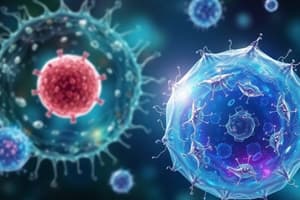Podcast
Questions and Answers
Is a yeast cell prokaryotic or eukaryotic?
Is a yeast cell prokaryotic or eukaryotic?
- Eukaryotic (correct)
- Prokaryotic
Classify a cell from Elodea as eukaryotic or prokaryotic.
Classify a cell from Elodea as eukaryotic or prokaryotic.
- Eukaryotic (correct)
- Prokaryotic
Is Streptococcus, a bacteria, eukaryotic or prokaryotic?
Is Streptococcus, a bacteria, eukaryotic or prokaryotic?
- Prokaryotic (correct)
- Eukaryotic
Is a photosynthetic plant cell eukaryotic or prokaryotic?
Is a photosynthetic plant cell eukaryotic or prokaryotic?
What are organelles?
What are organelles?
Give an example of archaebacteria.
Give an example of archaebacteria.
Give an example of eubacteria.
Give an example of eubacteria.
Give an example of a protist.
Give an example of a protist.
Give an example of a fungi.
Give an example of a fungi.
Give an example of a plantae.
Give an example of a plantae.
Give an example of an animalia.
Give an example of an animalia.
What is a heterotroph?
What is a heterotroph?
What does unicellular mean?
What does unicellular mean?
What does multicellular mean?
What does multicellular mean?
In sexual reproduction, new genetic material is ____% from one parent and ____% from the other.
In sexual reproduction, new genetic material is ____% from one parent and ____% from the other.
In asexual reproduction, ____ genetically identical cells are produced.
In asexual reproduction, ____ genetically identical cells are produced.
How many basic kingdoms are there?
How many basic kingdoms are there?
Is a prokaryotic cell unicellular or multicellular?
Is a prokaryotic cell unicellular or multicellular?
True or false: A prokaryotic cell is primitive.
True or false: A prokaryotic cell is primitive.
Where is the DNA in a eukaryotic cell?
Where is the DNA in a eukaryotic cell?
Flashcards are hidden until you start studying
Study Notes
Cell Types and Classification
- Yeast cells and photosynthetic plant cells are classified as eukaryotic due to the presence of a nucleus and membrane-bound organelles.
- Elodea, a type of aquatic plant, also categorizes as eukaryotic for similar reasons.
- Streptococcus, a bacterial organism, is prokaryotic; all bacteria belong to this classification.
- Prokaryotic cells, like Streptococcus, lack a nucleus and membrane-bound organelles.
Organelles and Function
- Organelles are specialized membrane-bound compartments within eukaryotic cells that perform distinct functions essential for cellular operation.
Examples of Organisms by Kingdom
- Archaebacteria (e.g., Joostella marina) are prokaryotic organisms.
- Eubacteria (e.g., Bacillus anthracis) are also classified as prokaryotic.
- Protists, such as Paramecium, are examples of eukaryotic organisms.
- Fungi, represented by Pilobolus, are classified as eukaryotic.
- Plantae, such as the venus flytrap, and Animalia, like the three-toed sloth, are both eukaryotic domains.
Nutrition and Cell Structure
- Heterotrophs are organisms that derive energy by consuming other living things, unlike autotrophs which produce their own food.
- Unicellular organisms consist of a single cell, while multicellular organisms are composed of multiple cells.
Reproductive Strategies
- Sexual reproduction results in offspring that possess genetic material from both parents, contributing to genetic diversity.
- Asexual reproduction produces two genetically identical cells, ensuring uniformity of the offspring.
Kingdoms of Life
- There are six primary kingdoms: Fungi, Animalia, Plantae, Protista, Bacteria, and Archaea, which encompass all known life forms.
Prokaryotic Cell Characteristics
- Prokaryotic cells are typically unicellular and have a simpler structure compared to eukaryotic cells, leading to the classification as primitive.
Genetic Material Location
- In eukaryotic cells, DNA is housed within the nucleus, separating it from the cytoplasm and allowing for greater complexity in gene expression and regulation.
Studying That Suits You
Use AI to generate personalized quizzes and flashcards to suit your learning preferences.




